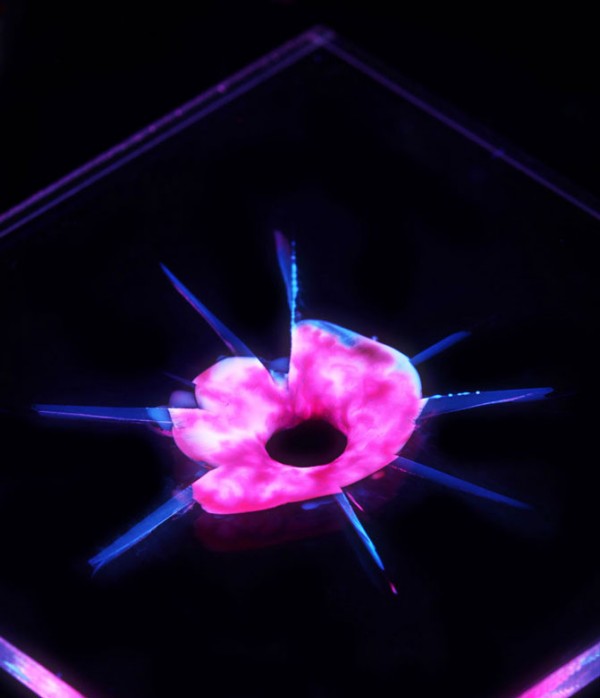Incredible New "Healing" Plastic Developed with the Help of the US Air Force
| Robert Sarkanen | | May 12, 2014 05:18 AM EDT |
(Photo : Ryan Gergely) The healing process caught in action: the red and blue are the two liquids combining to form the regenerating gel.
Illinois researchers have developed a plastic material that regenerates like living tissue in a new study supported by the US Air Force.
The incredible invention, developed by Professor Scott White and a team of professors and graduate students of the University of Illinois at Urbana-Champaign, was published as a new study called "Restoration of Large Damage Volumes in Polymers".
Like Us on Facebook
Jeffry S. Moore, team member and professor of chemistry, claims it not only heals, but repairs itself by regrowth in a way seen only in living systems.
Such self-repair abilities could potentially mean huge business with many far reaching applications from household items and automobile design to aerospace and significant military applications. As a result, the study was officially supported by the Air Force Office of Scientific Research.
The material was based on prior work that developed "vascular materials" with specially designed fibers that disintegrate, resembling the body's capillaries or thin blood vessels beneath our skin.
This vascular delivery system allows researchers to deliver large quantities of healing agents to restore the damaged parts.
The healing agent consists of two chemicals, spread out over every other capillary, that flow out when damage occurs. When the two liquids mix, they form a gel that fills in the gaps caused by the damage and hardens into a strong polymer, thus restoring the plastic.
The team demonstrated the system on two different kinds of commercial plastic: thermoplastic and thermosets, that both constitute the biggest classes of plastics in use.
The researchers also had to find a way to control the speed of gel formation and hardening, depending on the damage type. A bullet impact, for instance, would cause radiating cracks as well as a hole at the point of impact. So the researchers developed a gel reaction slow enough to allow the chemicals to seep into the cracks first.
According to the report, the long term goal of the research is to develop a whole series of commercial plastics and polymers that can truly mimic biological healing against all types of damage.
Current development is underway to optimize the regenerative chemicals for a variety of different materials.
It is not clear if the Air Force's support of the research would mean that the exclusive rights of the materials would go to the US armed forces.
TagsRegenerating, Plastic, Polymer, Military, Air Force, University of Illinois, Healing, Vascular, Aerospace
©2015 Chinatopix All rights reserved. Do not reproduce without permission
EDITOR'S PICKS
-

Did the Trump administration just announce plans for a trade war with ‘hostile’ China and Russia?
-

US Senate passes Taiwan travel bill slammed by China
-

As Yan Sihong’s family grieves, here are other Chinese students who went missing abroad. Some have never been found
-

Beijing blasts Western critics who ‘smear China’ with the term sharp power
-

China Envoy Seeks to Defuse Tensions With U.S. as a Trade War Brews
-

Singapore's Deputy PM Provides Bitcoin Vote of Confidence Amid China's Blanket Bans
-

China warns investors over risks in overseas virtual currency trading
-

Chinese government most trustworthy: survey
-

Kashima Antlers On Course For Back-To-Back Titles
MOST POPULAR
LATEST NEWS
Zhou Yongkang: China's Former Security Chief Sentenced to Life in Prison

China's former Chief of the Ministry of Public Security, Zhou Yongkang, has been given a life sentence after he was found guilty of abusing his office, bribery and deliberately ... Full Article
TRENDING STORY

China Pork Prices Expected to Stabilize As The Supplies Recover

Elephone P9000 Smartphone is now on Sale on Amazon India

There's a Big Chance Cliffhangers Won't Still Be Resolved When Grey's Anatomy Season 13 Returns

Supreme Court Ruled on Samsung vs Apple Dispute for Patent Infringement

Microsoft Surface Pro 5 Rumors and Release Date: What is the Latest?










